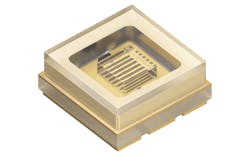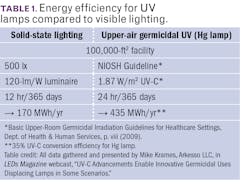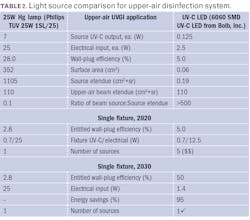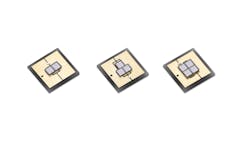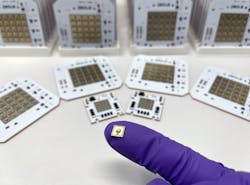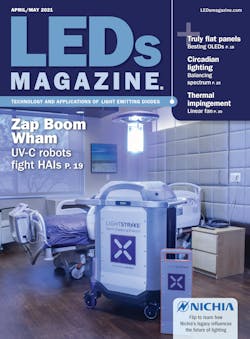Application fit overrules power and cost in consideration of evolving UV-C LEDs (MAGAZINE)
The simple way to compare germicidal ultraviolet (UV) LEDs, primarily UV-C-band (100–280-nm) LEDs, to legacy UV sources such as mercury lamps is an examination of output power and cost. In a recent LEDs Magazine webcast, however, presenter Dr. Mike Krames said the comparison of output in watts (W) or in dollars per watt yields useless conclusions unless you consider the sources relative to a specific application. Krames said UV-C LEDs will catch legacy sources in the general sense by the end of the decade, but he also said that in some applications the LEDs are already superior to lamps.
Krames spent the first half of the webcast digging into the details of the compound semiconductor puzzle of LEDs and describing materials and techniques used in visible-light LEDs and pointing out roadblocks for manufacturers of UV-C LEDs. The pace of research in UV-C LEDs has skyrocketed, motivated by the COVID-19 pandemic, but hard work remains. The presentation was an extension of the material he covered in a contributed article to LEDs Magazine on UV-C LED technology last year.
UV-C LEDs in applications
The new material in the webcast presentation focused more on where UV-C LEDs might fit in terms of applications in the near term, how the technology will mature, and what the market prospects might be. Krames provided context for the discussion by focusing on a single UV-C application — upper-air disinfection in a room. We covered the upper-air concept in some detail back in our January/February special report on UV-C usage in educational facilities.
Upper-air disinfection systems have perhaps been used more in medical facilities than anywhere else. A properly designed system can control the UV-C beam in a horizontal plane near the ceiling such that pathogens in the air that rise near the ceiling are deactivated. And as we have covered in past webcasts and articles, UV-C energy is absorbed by many materials, so it doesn’t tend to get reflected downward toward people in a space with an installed upper-air fixture. There is more discussion of the safety factor in the companion article for this special report.
Krames first set out to compare the performance of visible lighting systems with an upper-air germicidal fixture based on a mercury lamp. He did not specify the particular products compared, but simply said they are typical of what is on the market today. Such a comparison may seem irrelevant, but Krames had a point to make, as you will soon realize.
Table 1 summarizes the performance of the theoretical visible-light and upper-air germicidal systems as if they were both installed throughout a 100,000-ft2 facility. The visible-light system calculations assumed that the installation delivered 500 lx throughout the facility. The germicidal calculations are based on NIOSH (National Institute for Occupational Safety and Health) guidelines for germicidal irradiation in healthcare settings published by the US CDC (Centers for Disease Control and Prevention).
The LED-based, visible-light systems would require 170 MWh/yr of electricity to operate 12 hours every day. Krames based the mercury (Hg) lamp system operation on 24 hours per day, or basic continuous disinfection. The calculation assumed 35% efficiency for the mercury lamp, which may be better performance than such products deliver. The germicidal system requires more than 2.5× the energy of the visible-light system. Even if you reduced operation of the germicidal system to 12 hours per day, you would spend more money on disinfection than on lighting, and electrical lighting remains among the largest electrical loads in buildings. Krames suggested that building owners and facility managers would not accept such operational expense.
LEDs vs. mercury lamps
Having evaluated the relative inefficiency of mercury lamps in an upper-air disinfection application, Krames moved to evaluate the cause of the inefficiency and how UV-C LEDs might compare in the application. The following discussion relies heavily on the concept of etendue, a French word meaning “scope” or “expanse.” In an optical system, etendue is a metric that is the product of the size (area) of a light source and the solid beam angle produced by the source. You can calculate etendue of a light source, or etendue of a light source combined with other elements such as lenses or reflectors in an optical system. Etendue can be expressed in several ways, but here Krames uses units of cm2 × steradian (sr).
Etendue in an optical system follows conservation of energy principles. You can have an LED source, for instance, coupled with a lens that makes the effective size of the source larger than the LED dimensions while narrowing the beam angle. But you can never have an optic that could make the effective source size smaller and the beam angle narrower. The principles of etendue are one reason the small size of LEDs is so important in luminaires such as spotlights with maximum punch for lighting items such as retail goods.
Table 2 includes key parameters of an upper-air disinfection system based on mercury lamps and 2020-era UV-C LEDs. A key element in such a system is beam control. The UV-C radiation must be kept in the upper couple of feet of the room adjacent to the ceiling to ensure the safety of people in the space. But UV-C lamps are not directional sources. Typical lamp-based luminaire designs use a set of baffles mated to the lamp to create what Krames called a knife-blade-like beam pattern across the upper reaches of a room.
Etendue mismatch
The non-directional mercury lamp has a very high etendue rating from a source perspective because of the large surface area and wide beam angle. But the beam etendue will prove the limiting factor. Krames calculated the beam etendue using the area of the front surface of the luminaire and the beam limits defined by ASHRAE. When you compare the beam to source etendue, the optical efficiency of the system is 10%. The other 90% of the energy is wasted due to optical inefficiency in the application.
The next section of the table shows a comparison of mercury and LED upper-air systems today. The wall-plug efficiency of the mercury system is only 2.8%, or 10% of the lamp efficiency. The LED wall-plug efficiency is almost double. Both systems deliver 700 mW of effective UV-C energy, but the LED system does that with half of the electrical power. But the upfront cost of the LED system is still much higher because you need five UV-C LEDs. Krames said mercury lamps cost about $1/W today relative to the aforementioned $80/W for LEDs. Still, the LED system would deliver return on investment (ROI) when operational costs are considered. Moreover, the LED alternative would offer significant freedom in terms of form factor.
And the third section of the table projects where the LED alternative is headed. By 2030, a single UV-C LED will deliver more UV-C energy than will the mercury option. Moreover, it will deliver 95% energy savings. Krames said at that point LEDs will make adding upper-air disinfection a negligible expense from an energy use perspective.
To support the idea that UV-C LEDs are a better choice today in upper-air systems, Krames reminded the audience of the situation in 2010 when fluorescent tubes dominated liquid-crystal display (LCD) backlight applications. In a matter of a year, LED backlights took over despite a 20× upfront cost advantage for fluorescent. LEDs won based on performance benefits, energy savings, and the promise of cost reduction. Today, UV-C LEDs already match mercury lamps in lifetime, can be cycled on and off, don’t contain a hazardous substance, and deliver an energy-efficiency advantage. About mercury lamp upper-air systems, Krames said, “The best you can do is 10% efficiency. It’s awful.”
LED evolution
It’s also worth noting the changes taking place in the UV-C LED sector, which have shown movement even over a short period of time. First of all, the number of manufacturers in the space has grown. A year or two ago, we had mostly specialty manufacturers focused on UV technology making such LEDs. Seoul Semiconductor was probably the first mainstream LED manufacturer to devote significant resources to the sector through its Seoul Viosys and Sensor Electronic Technology Inc (SETi) subsidiaries.
Nichia has become deeply involved in the UV-C sector. Erik Swenson of Nichia recently contributed a column to our magazine focused on the need for full disclosure of performance metrics with UV-C LEDs.
Osram Opto Semiconductors has long participated in the infrared (IR) region at the opposite end of the human visible spectrum from UV but had not traditionally made UV LEDs. Still, the company had been involved in some major European R&D projects focused on UV-C for some time. Just prior to the end of 2020, Osram announced its first UV-C packaged LEDs. Then two months back, Osram announced that it had acquired a 20% stake in UV-C LED startup Bolb.
Krames cited Bolb as having some technology that could overcome some fundamental issues with UV photon extraction while also lowering forward voltage. Moreover, the company’s 6060 UV-C LED was the basis for the upper-air comparison Krames made. The company has high-power packaged LEDs approaching 100-mW output. And the company has shown array-based modules that operate at 2.5W.
Luminus, which makes a variety of visible-light LEDs, has also been very active in the UV-C space of late. The company’s most recent announcement includes multiple models all in a 5×5-mm footprint package. The packages are akin to discrete LED packages, but Luminus has models that integrate 2, 3, or 4 chips into the package. The 4-chip devices can deliver 240 mW and Luminus said it sells for less than the $80/W level mentioned by Krames.
The subject of far-UV-C LEDs in the 222-nm range was also discussed during the webcast. In another UV-C-focused webcast last year, Dr. Bob Karlicek of the Center for Lighting Enabled Systems & Applications (LESA) at Rensselaer Polytechnic Institute suggested that physical limits would not allow the LED industry to produce far-UV-C components. Karlicek and a colleague also wrote a column on UV-C for our magazine. Krames disagrees. His analysis is that 230 nm is certainly a wavelength that the industry can realize, and he believes that 222 nm is possible.
During the webcast, Krames was repeatedly bullish on manufacturers making the same performance ramp that visible-light LED makers made a decade ago. Moreover, he pointed out that market researchers project a very opportunity-laden market. Recent Yole research projects $2.5 billion in UV-C LED revenue in 2025. That could be near half of the revenue of visible-light LEDs.
Still, after the webcast presentation, an attendee wanted to know how many LEDs would be required to match the output of a mercury tube even though Krames had made the point that such comparisons aren’t relevant. And he isn’t the only UV expert saying such things. For example, UV-C-LED specialist Crystal IS contributed an article to LEDs Magazine almost three years ago discussing the need for an application match.
In answer to the question, Krames said, “It depends on the application. The important thing to remember is that the germicidal efficacy is intensity driven. It’s not flux driven. It doesn’t matter how many watts you have out, it matters how many watts/cm2. The LEDs have two orders-of-magnitude higher radiance than the mercury lamp. So they are going to be faster.” By faster, Krames meant in deactivating a pathogen.
He continued, “If you have an application where you have a gigantic volume you are working with, then it gets more to a watts-per-watts basis. Right now, on a watts-per-watts basis, that is tough for LEDs. But in any application where you want to go to fast germicidal activity, or where you are etendue constrained like upper-air germicidal UV, LEDs can provide an enormous advantage. Don’t compare on a watt-by-watt basis. It’s not the right comparison. You have to look at the application and compare on the right metrics.”
LEDs Magazine chief editor MAURY WRIGHT is an electronics engineer turned technology journalist, who has focused specifically on the LED & Lighting industry for the past decade.
Enjoyed this article? Visit our digital magazine for more like this >>

Maury Wright | Editor in Chief
Maury Wright is an electronics engineer turned technology journalist, who has focused specifically on the LED & Lighting industry for the past decade. Wright first wrote for LEDs Magazine as a contractor in 2010, and took over as Editor-in-Chief in 2012. He has broad experience in technology areas ranging from microprocessors to digital media to wireless networks that he gained over 30 years in the trade press. Wright has experience running global editorial operations, such as during his tenure as worldwide editorial director of EDN Magazine, and has been instrumental in launching publication websites going back to the earliest days of the Internet. Wright has won numerous industry awards, including multiple ASBPE national awards for B2B journalism excellence, and has received finalist recognition for LEDs Magazine in the FOLIO Eddie Awards. He received a BS in electrical engineering from Auburn University.

